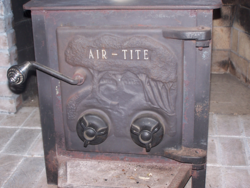I've been lurking and reading, but still a newbie. We bought a house in the late winter and burned a bit while remodeling. However, by the time we actually moved in, it was spring and we really didn't have to rely on the stove for heat. Now we are into overnight lows of 30 (Western MA) and we intend to heat 100% with wood. The late 70s house came with what is likely the original wood stove. The chimney sweep was impressed -- called it a Sherman tank. Not the most efficient and certainly not EPA friendly, but it will heat the house (2300 sq. ft.). It's a massive thing -- firebox is 28" deep, 14" wide, 18" high. I've looked online to see who made it or to learn more about it, but I can't seem to find much information. The front of the stove has a raised tree on the door and the words "Air-Tite" across the front. It was two air intake valves on the front. So that's what we're dealing with, if anyone recognizes it.
Here's where I need some help from you more experienced folks. How do I keep a consistent temp in this thing? Granted I'm new to this, but I find myself checking the Condar stove top temp gauge every 20 minutes. The chimney sweep said to keep it between 550 and 650. We get the fire going with some Fatwood and kindling. We load about 5 splits (about 30% of the firebox capacity), keep the door ajar an inch or two for about 5-10 minutes, and since we're burning some good seasoned oak, it can get to well over 650 pretty quickly. We start closing the air off, and to keep it under 650, the valves are nearly closed. Is this OK? We're only burning in the evenings right now to take the chill out of the house, but I'm concerned about keeping this beast between 550 and 650 24/7 once winter arrives.
Open to any and all information you can share! Thanks!
Here's where I need some help from you more experienced folks. How do I keep a consistent temp in this thing? Granted I'm new to this, but I find myself checking the Condar stove top temp gauge every 20 minutes. The chimney sweep said to keep it between 550 and 650. We get the fire going with some Fatwood and kindling. We load about 5 splits (about 30% of the firebox capacity), keep the door ajar an inch or two for about 5-10 minutes, and since we're burning some good seasoned oak, it can get to well over 650 pretty quickly. We start closing the air off, and to keep it under 650, the valves are nearly closed. Is this OK? We're only burning in the evenings right now to take the chill out of the house, but I'm concerned about keeping this beast between 550 and 650 24/7 once winter arrives.
Open to any and all information you can share! Thanks!


